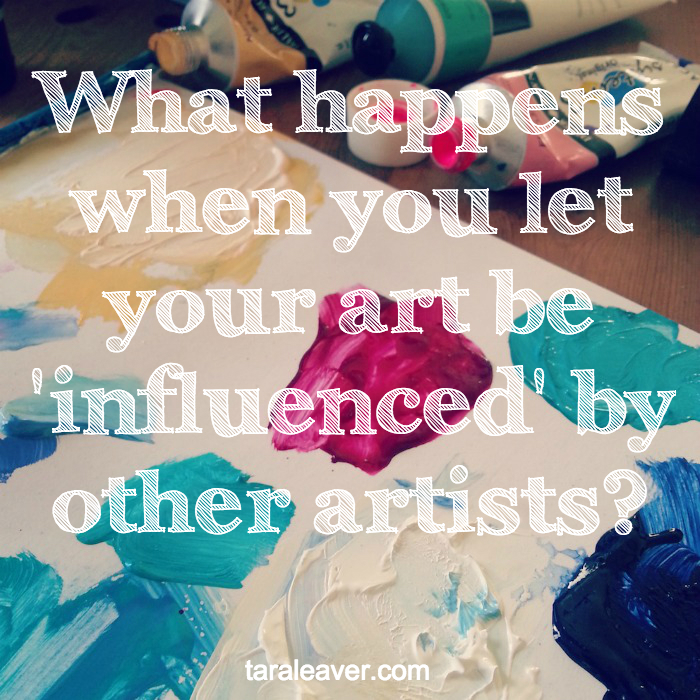
Today I’m going to do something that makes me feel a bit awkward. I’m going to show you some work I’ve done over the years that was very heavily influenced by other artists. What can I say friends, I don’t choose the post ideas; they just come to me and I assume there’s a reason and someone needs to see them, so I share them here.
Plus I learned something absolutely crucial for any artist which you can probably guess, but I’ll leave that little nugget till the end. 🙂
Obviously I’d never advocate ripping off another artist’s work and passing it off as your own or selling it. What I do generally support though is allowing yourself to be inspired and influenced by other artists, insofar as it informs your own work.
Beyond the copyright issues, of which we’re all basically aware, I can see there’s an argument both for and against having a go at another artist’s style or technique.
On the one hand, it can help us learn by trying things we might not have thought of and stretching our artist vocabulary in terms of marks, colour palettes and so on.
On the other, it can stunt our learning and growth as an artist because we’re not digging into what’s actually ours. And even if you don’t think there’s much in there, as I’ve thought many times about myself, I can assure you that if the urge is in you, there’s a rich mine of art goodness inside you just waiting to be revealed. The urge is the sign.
I’d go one step further in fact and say that copying without taking the time to investigate what’s ours does not just the original artist a huge disservice, but extends that disservice to ourselves and deprives the the world of the work that only you can bring to it. I know people say that all the time and it can be really annoying, but that’s probably because it’s true. 😉
To demonstrate my point, I thought I’d take you on a little tour of my personal history of trying on other artists’ styles for size. I want to be clear that it was never about actual copying or trying to make money from doing so {although I did sell pieces on a couple of occasions}. It was a conscious choice for personal {and sometimes private} exploration.
When I was just starting to get my art groove back after its dormant years, I did try on a lot of different styles, mainly by taking courses with artists whose work I loved, which is often a sure fire way to end up with similar artwork. {And the number one reason I created Abstractify.} I shared some of them in this post, but these are mostly older {and that much more uncomfortable to share}. 🙂
So let’s see what we can dig out from the dusty archives…
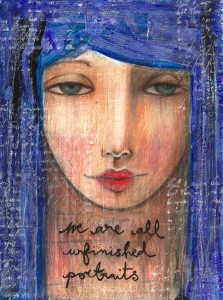 One of the first online courses I took was with Suzi Blu, known for her stylised and perfect faces. She inspired me hugely at a time when I felt very low and unsure of who I was, with her quirky and bold personality. This painting came straight from that course and is a version of the one she showed us how to create, step by step. For a long time it was my single most popular piece of art. People loved it. I was pleased with it, mainly because I spent a lot of time and care on it, and as a total ecourse virgin had uncovered a whole new art world. I did a few more, but they never felt like mine and didn’t really ‘hit home’ for me. This style is very popular with many mixed media artists, just not this one. 🙂
One of the first online courses I took was with Suzi Blu, known for her stylised and perfect faces. She inspired me hugely at a time when I felt very low and unsure of who I was, with her quirky and bold personality. This painting came straight from that course and is a version of the one she showed us how to create, step by step. For a long time it was my single most popular piece of art. People loved it. I was pleased with it, mainly because I spent a lot of time and care on it, and as a total ecourse virgin had uncovered a whole new art world. I did a few more, but they never felt like mine and didn’t really ‘hit home’ for me. This style is very popular with many mixed media artists, just not this one. 🙂
Lesson: Whimsical girls are not my thing. I learned a lot of useful mixed media techniques and have fond memories of those early days, but ultimately this was a stepping stone for me, not a final destination {not that there ever really is one in art}. Bonus lesson: learning what you don’t love can be just as useful as learning what you do.
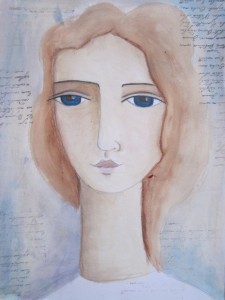 I took a course with Pam Carriker about creating portraits, and this one shows her style very strongly. Again this was very early on and I had no idea what my own personal style was. I was basically gorging at the buffet because it all looked so enticing. I’m glad I did that because it taught me so much from both sides of the table in terms of what felt good and what felt like trying too hard, or faking it.
I took a course with Pam Carriker about creating portraits, and this one shows her style very strongly. Again this was very early on and I had no idea what my own personal style was. I was basically gorging at the buffet because it all looked so enticing. I’m glad I did that because it taught me so much from both sides of the table in terms of what felt good and what felt like trying too hard, or faking it.
Lesson: Fun and informing, and I learned a lot about layering, but yeah, portraits are not really my thing, especially neat ones. {Interestingly I have repeatedly tried them over the years, through courses and personal experimentation. I’ve found a way to do them that I enjoy now, but they are still not my favourite thing. I have no idea why I keep trying!}
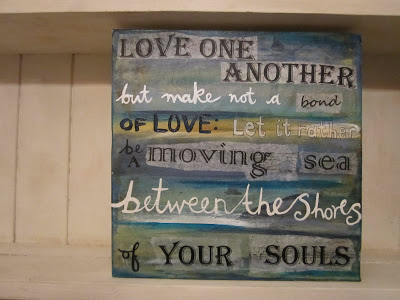 Mae Chevrette was one of the first mixed media artists I discovered and I fell in love with her work instantly. She has worked her arse off over the past 7 years {probably longer, but that’s when I found her}, developed her very unique style into something beautifully finessed and unforgettable, and her art is hugely and deservedly popular. This is what happened when I had a go. {I’m laughing my head off right now. Ah, bless my younger self.} I don’t think Mae has anything to worry about there.
Mae Chevrette was one of the first mixed media artists I discovered and I fell in love with her work instantly. She has worked her arse off over the past 7 years {probably longer, but that’s when I found her}, developed her very unique style into something beautifully finessed and unforgettable, and her art is hugely and deservedly popular. This is what happened when I had a go. {I’m laughing my head off right now. Ah, bless my younger self.} I don’t think Mae has anything to worry about there.
Lesson: Lettering is fun but I tire of it quickly, not being a detail oriented person, and tend to be frustrated by my lack of finesse with it. I don’t love it enough to try harder. Not Mine.
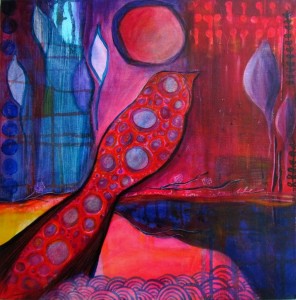 Flora Bowley probably needs no introduction. 🙂 Through a strange sequence of events that each seemed very innocuous at the time and only strung together in retrospect, I ended up in one of her early classes at a retreat in 2011. I actually did this painting before that, and her influence is evident. This was a very early painting for me, when I started venturing onto slightly larger canvases.
Flora Bowley probably needs no introduction. 🙂 Through a strange sequence of events that each seemed very innocuous at the time and only strung together in retrospect, I ended up in one of her early classes at a retreat in 2011. I actually did this painting before that, and her influence is evident. This was a very early painting for me, when I started venturing onto slightly larger canvases.
Lesson: Intuitive art plays quite a large part in my natural approach to painting. However the point of intuitive art is that it’s intuitive, not borrowed, and intuition comes through in unique-to-us ways. Time spent exploring what’s intuitive to {and from} me took me away from Flora’s style and into my own realms.
Oh how I love Leah’s art. It’s so feminine and archetypal, simple but often powerful, and so graceful. She often uses ink blots, which encourage the intuitive aspect of her art. I played around with that for a while. I found Leah in the early days too, although this is actually a more recent drawing {a couple of years ago}. You never know when the urge to try something out might hit.
Lesson: Fun, but too delicate and small for the way I want to express myself, and ultimately not my style. I also prefer to work on a much larger scale with many layers and textures.
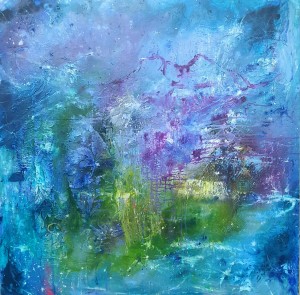 Emma Lindstrom is a recent discovery and I’m still having a total love affair with her work. I knew I couldn’t replicate it, but I wanted to have a go in my own way as a way to better understand it. This was a major experiment and was not a success for me, if success means you’re happy with the outcome. It was a success in what I learned though, and the canvas will be useful as a base for a new painting. I learned a lot from this, probably more than in the past because I actually do know what my natural style is now so that element of the search wasn’t present.
Emma Lindstrom is a recent discovery and I’m still having a total love affair with her work. I knew I couldn’t replicate it, but I wanted to have a go in my own way as a way to better understand it. This was a major experiment and was not a success for me, if success means you’re happy with the outcome. It was a success in what I learned though, and the canvas will be useful as a base for a new painting. I learned a lot from this, probably more than in the past because I actually do know what my natural style is now so that element of the search wasn’t present.
Lesson: It was fun for a bit, but…I don’t like to work on the floor; it felt out of control and the paint got everywhere. I love me some artistic mess, but this was just annoying and distracting so I never got fully into it. Admittedly I probably didn’t need to do an experiment on my largest canvas. I find it very tedious to mix all my paints beforehand; I like to squeeze them straight from the tube and do most of my mixing on the canvas. I also need to use a brush; I hadn’t realised before how intimately it connects me to the painting. It’s a direct bridge between my soul and the art, for want of a better way to put it. Pouring and swirling feels too disconnected for me. {This is such great information to have.} No matter how much I want to paint cosmic galaxies, it’s not my area and best left to people like Emma who can do it with depth and beauty.
Conclusion
You can see from this little romp through my attempts at other artists’ styles and techniques that:
- Copying, unless you’re doing an exact replica {which is questionable for various reasons}, never looks that good. Why? Because it lacks integrity, and even when we can’t put our finger on it we can feel it when we see it.
- Allowing yourself to be heavily influenced by another artist for the purposes of your own learning only can produce some key insights into what you do and don’t love, what does and doesn’t come naturally for you, and how you really want to make art.
- And the big daddy that I learned from all this: I actually CAN’T paint like other artists, and nor do I want to. That’s the best thing this exercise has taught me over the years; it’s fun to experiment, to try out what other artists are doing , but if I only ever did that I’d be unfulfilled and dissatisfied. I’d be surrounded by a vegetarian buffet and craving steak. {I do not know what’s with all the buffet references today. I should probably eat something.}
So that is awesome news. I’d hazard a guess that it’s true for you too, wherever you are in your artist journey. We all want to be in integrity. Copying can act as a signpost, or a series of signposts, back to your own unique path and your own unique style. Just don’t take a detour and never come home, ok?
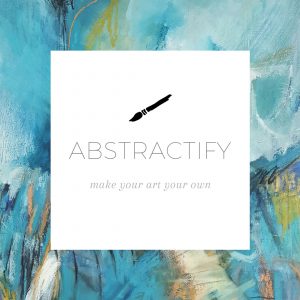 Struggling with that fine line between springboards of inspiration and the whirlpool of copying? Abstractify might be a good course for you!
Struggling with that fine line between springboards of inspiration and the whirlpool of copying? Abstractify might be a good course for you!
It’s all about finding your own voice, by exploring your options. It’s part of the Happy Artist Studio, which means that if you join for Abstractify, you’ll actually get access to a lot more courses and resources! Click here to find out more.

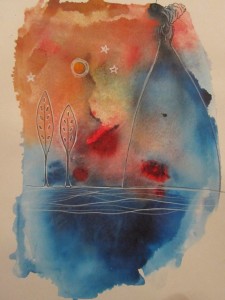






Excellent post! Really honest and interesting to read. So often we find work and artists whose work we just love – I wonder if sometimes it’s precisely because we know (deep down) that we can’t do it their way. It can be a fine line between admiration and copying a style. For me the struggle has been more with finding a ‘subject matter’ that feels true. Not pure abstract, not traditional landscape, but figuring out that sweet spot in the middle – and making it my way. Still figuring out how the urban influences that are so much part of my life will fit in. Following others can be truly inspiring, but also a distraction that takes us away from working through our own artistic concerns – after all, it’s easier to follow a guide than cut your own route through the jungle. Keep slashing!!
Glad you found it interesting Alice! I find your point about whether we deep down know we can’t do it someone else’s way really interesting. I think that is true for me a lot of the time. Some of my favourite art definitely falls into the category of ‘way outside my realm of capability’. Great point too about finding your subject matter. I’m very much leaning towards abstract landscapes recently but am still feeling they could be more ‘me’ somehow. It’s an ongoing quest! Which I think is part of what makes it fun and interesting. I’ll be interested to see if and how you start bringing in the urban influences in your work.
Just saw this post via your FB page. So true. I like your exploratory experiments from Pam, Flora, and Leah and they inspire me to try some of those ideas.
Great! Always happy when someone leaves the blog inspired. 🙂